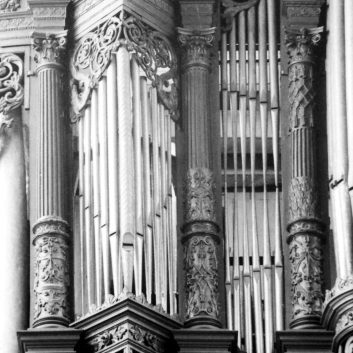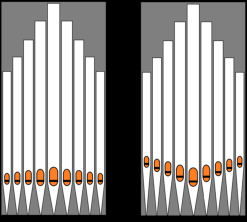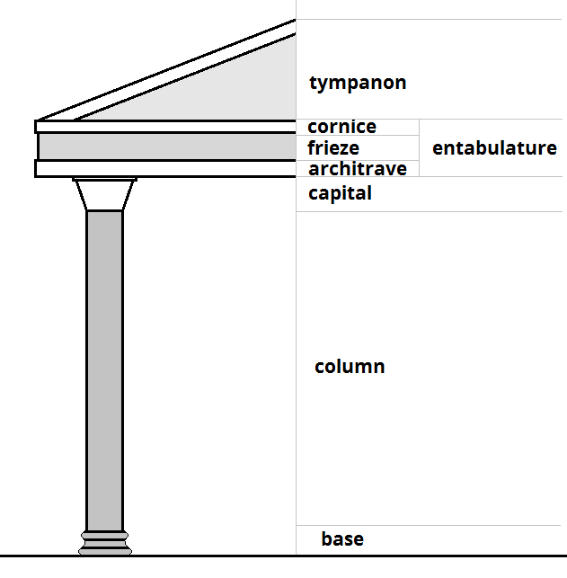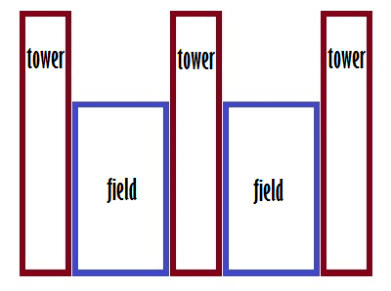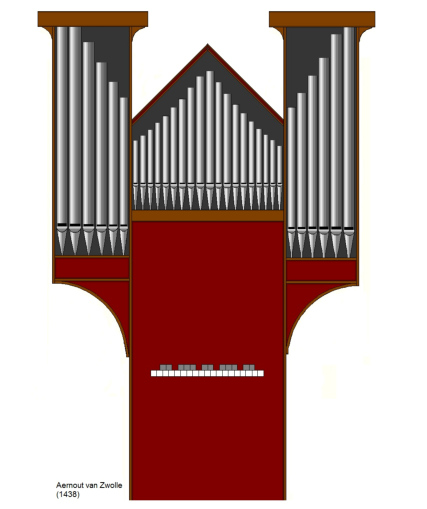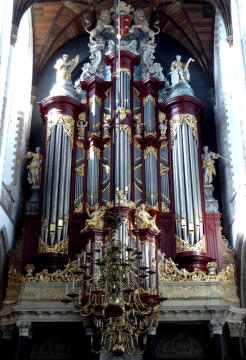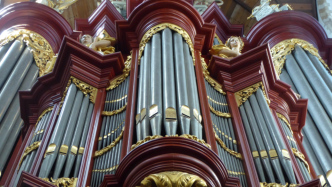
$0.00
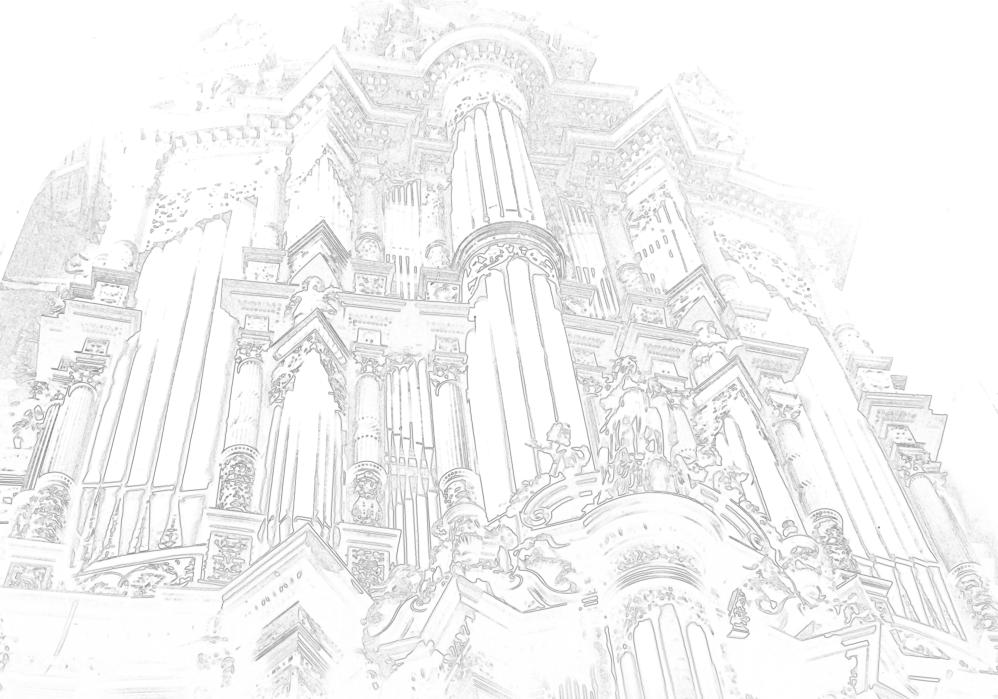
Decorative elements of the facade
of the 17th century organ
in the Saint-Johns Cathedral of Bois-le-Duc
Only a few times the organ in his appearance as a wooden case was subject of an art history study.
A number of studies is well known: the study of Floris van der Mueren from 1931 1 and of
Brunzema from 1953 2. Renowned is the book of the american author Arthur Hill from 1883,
containing a huge number of pencil drawings of organ fassades in Europe, some of which did not
survive the First World War.
Purpose of this essay is to provide a description of the decorative elements of the case of the main
organ of the Cathedral Basilica of Bois-le-Duc dating from the 17th century.
For the understanding of the technical terms used first follows a introduction for the organ as well as
the art history.
skip the introduction - go straight to the article about the organ case of Bois-le-Duc here
introduction to the organ
The pipe organ, 2000 years old, is the largest and technically most complicated musical instrument of
the West European culture.
The organ consists of the following parts:
Wind supply Pressurized air, necessary to make pipes sound, is called “wind”. The supply system
consists of mechanical bellows or electrical blowers in connection with wind channels transporting the
wind to the wind chests.
Wind chests a number of long, flat and airtight chests, containing the wind and distributing the wind
over the pipes. The wind chests are arranged next to each other or on two ore more floors of the
case.
The tracker action is a mechanical system, that allows the organist to open the valves under the
pipes by pressing keys using hands and feet. This makes the pipes sound.
Pneumatical and electrical systems are also possible.
The pipes are in rows on the wind chests. The number of pipes can range from a few hunderd to
thousands. The largest pipes can measure more than eight meters and a weight of hunderds of kilos.
The total weight of all these, mainly metal pipes can be thousands of kilos, which places high
demands on the wooden construction around it.
The case/casing is the wooden shell for the preceding parts. It has a number of functions:
The wooden construction carries the weight of pipes, wind chests and wind supply (image A). In
addition the closed casing protects the instrument against dust, birds, bats and people, but also
against moisture from the ceiling, direct sunlight and large and rapid temperature changes.
Moreover the case has the function of resonance box: it collects and mixes the sound of the pipes
inside and emits the resulting sound at the front. The visible front of the organ casing is called “front”
or “facade”.
The fassade/facade shows only a small number of the organ pipes. These pipes are painted or
polished. The fassade reflects the way the organ is setup as a musical instrument.
the organ
In time the number of pipes increases. To be able to contol it, the organ was divided in two ore more
smaller organs within the same case. Each organ has its own keys; all the smaller organs can be
played separately as well as together. Each smaller organ is called a “werk” or sometimes
“positief/positiv”. The kinds of “werk” are:
The hoofdwerk (meaning: main organ): commonly the largest organ with always the most powerful
sound.
The bovenwerk (meaning: upper organ): placed on top of the hoofdwerk. The bovenwerk is less
powerfull and functions sometimes as a kind of echo of the hoofdwerk.
The rugwerk (meaning: organ at the back of the organist) is separated from the main case and is
built into the balustrade. The facade of this organ is often a diminished version of the facade of the
main case.
The pedaal has the largest pipes of the organ, providing the sound of the bass. It often takes the
form of semicircular towers; the keys of the pedaal are played with the feet.
The image on the left represents the facade of the Renaissance organ of Bois-le-Duc. This kind of
facade, build according to the werk-prinzip , in which the position of the smaller organs is visible, is
common in northwestern Europe.
the facade
In general organ builders always did consider case and pipework a unity. One of the tasks of the case
is to collect and mix the sound of the individual pipes and emit the result between the facade pipes
into the space in the building.
Form and dimensions of the casing are mainly determined by the number and dimensions of the pipes
combined with the available space.
Until 1500 the flat facade was used; the facade pipes and the case make a straight line. The pipes
used in the facade of the organ are a special type called “Praestant” derived from “praestare” in Latin
meaning “to stand in front” and “to be important”.
When it was impossible to have all the pipes side by side in the facade, the smaller pipes were
arranged in two or three layers above each other; it prevented the facade from becoming
unnecessarily wide. Such an arrangement of the smaller pipes in a framed setup is called a “field” in
contrast to the “tower” of the larger pipes.
One typical Dutch arrangement is the “mirror field” or “spiegelveld” ; two rows of identical pipes are
set up one above the other and the lowest row upside down; the feet of the pipes are soldered
together so the pipes speak at the same time. The advantage of this construction is the optical beauty
of it as well as the fine sound of this “Double Praestant”. (see next page: images 9,10,15)
After 1500 the number of large pipes increases. To avoid major and costly enlargement of the casing,
the straight-line setup was abandoned; the pipes came forward in all kinds of forms: triangular, half
hexagonal or semi circular. This way more pipes could stand in front without widening the case.
In the Renaissance only the towers with the tallest pipes remain flat.
towers and fields
Making a fine combination of towers and fields is an important part of designing a organ facade.
For smaller organs often a three-part layout is used. For example the organ of Aernout van Zwolle
from 1438 (image left), having a low field in the middle and two towers aside; present also in the
oldest playable organ, in Sion, Switzerland. The setup of a tower in the middle with two fields aside
like in Midwolde is rare.
The combination commonly used for medium-seized organs is the facade in five parts, having three
towers and two fields. In the Netherlands the highest tower in the middle is the preferred facade,
frequently in two layers of pipes (Bois-le-Duc). In Germany the outside towers are the highest.
Inside the towers the pipes are symmetrical lined up, the largest pipe in the middle. Usually the
number of pipes is three, five or seven; towers with nine or eleven pipes are rare.
The flat fields in between the towers have different arrangements; frequently the length of the pipes
increases moving closer to the middle of the organ (Midwolde). Another arrangement is the
symmetrical line-up having the tallest pipes in the middle like the organ of Aernout van Zwolle and
many organs in Italy.
In the Baroque period the number of towers and fields increases as can be seen at the organ of the
Bavokerk in Haarlem (image left). This famous organ facade has nine parts including three semi
circular towers, two sharp triangular and divided towers, with four fields in between, of which two are
divided in two verical parts and the two remaining fields in three parts. The pedal towers on the
outside contain seven pipes and the other towers nine smaller pipes. The rugpositief has seven parts,
counting three towers and four fields. The central tower is undivided, as are the two triangular towers.
The slightly outside bent fields at the end of the case have two layers of pipes and the fields next to
the central tower are bending inwards being divided in three layers (image).
labia lines
The pipes also play an important decorative role in the facade. Highly decorative is the metal glow of
the polished pipes as well as the often gilded lips of the pipes, the “labia”.
By making the feet of the pipes different or equal in height the organ builder is able to create different
lines of labia in the facade.
Possible are a straight line, an oblique line and an V-shaped line with the point upwards or
downwards. (image left) This line is usualy continued in the adjacent carved wood.
Generally the labia lines of towers and fields connect and create together a long winding or straight
line. The straight line is rare in Northwest Europe but quite common in Middle and South Europe.
The painting of pipes and labia is common in Spain and in Victorian England; in Spain often masks or
faces are painted on the pipes, the mouth of which coincides with the labium.
art history
The following terms are used in the article about the case of the organ of Bois-le-Duc. A number of
forms are derived from classical Greek architecture.
Ionic after the Doric style/order the second of the Greek orders. The main difference with the Doric
order is the leaner column with different cannelures and a basement, and the more substantial and
sculpted capital with volutes.
Corinthian the third of the classic Greek orders; the main difference is the capital: the volutes
become smaller or disappear completely and the capital is covered with acanthus leaves.
cannelures a lenghtwise running groove on the surface of a column with the aim to making it
apprear slimmer.
pilastre halved columns attached to the wall behind it; ordinarily not supporting something.
capital upper part of a column making the transition between the vertical column and the horizontal
entabulature.
volutes visually defining part of the capital of the Ionic order. (image)
acanthus leave stylized leaf shape of the Acanthus plant; main part of the Corinthian capital.
entabulature the combination of architrave, frieze and cornice.
architrave lowest part of the entabulature consisting of elongated stones that run from column to
column.
frieze middle part of the entabulature, where once the end parts of the wooden beams were. Later
mainly decorative and sculpted.
cornice upper part of the entabulature, often protruding to keep the rain from the wall, profiled and
decorated with palmettes.
dentils part of the cornice in the Ionic order. bij de Ionische orde; a row of little cubes.
egg-and-dart molding decoration with alternating egg-shaped objects and arrowheads.
palmette architectural decoration crowning the cornice in the Corinthian order; resembling fan-
shaped leaves of a palm tree.
band of beads band between shaft and capital, sometimes a beads and reels pattern.
tympanon triangular and sculpted closure of the roof of a Greek temple.
aediculum small frame consisting of two columns, entabulature and tympanon; aediculum is a
latin word meaning: “little building”.
ogee profile, consisting of a quarter-round convex and a quarter-rond concave part, together
creating an S profile.
console protruding part of a wall, supporting beams, ribs or statues, frequently sculpted and
ornamented.
caryatide female figure used as a pilar to support a tabulature.
atlant complete male figure used as a pillar to support a tabulature.
herm/herma square pillar equipped with a men’s head or torso on top. The pillar is often becoming
gradually smaller going down. The herme has no supporting function, only decorative.
atlant upper half a male figure, used in a supporting function; the lower half is a console or pillar
basement/base the foot of an Ionic column, consisting of three rings which have a convex and a
hollow profile alternately.
cartouche ornamental tablet with text decorated on the outside with curly protusions.
festoon decoration of strings of braided leaves, flowers and fruits, bounded by ribbons and hanging
from two points.
putto decorative naked and chubby little boy, sometimes depicted with a musical instrument. Plural:
putti.
cherub a putto with wings. Plural: cherubim
fleuron ornament shaped like a flower.
chimera monster, with parts fabricated from a number of animals, like a lion’s head and a serpent’s
tail.
polychromatic multicolored or painted in different colors.
rosette circular, stylized flower or plant shaped design
satyr mask mask of an agressive man with a bestial face, wild beard and horns.
to the article
page top
introduction of:
